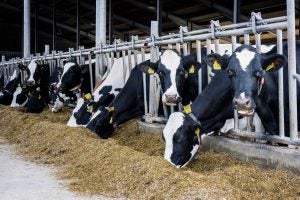State and federal animal health officials are investigating a contagious illness on dairies across the Southwest.
As of 2 p.m. CT, Texas Agriculture Commissioner Sid Miller received confirmation from U.S. Secretary of Agriculture Tom Vilsack and the Animal and Plant Health Inspection Service that the mystery disease has been identified as a strain of Highly Pathogenic Avian Influenza, commonly known as bird flu.
To date, three dairies in Texas and one in Kansas have tested positive for HPAI. The Texas Department of Agriculture is vigilantly monitoring this outbreak. AGDAILY has received reports of at least one dairy in Clovis, New Mexico, that has affected cattle as well.
Additionally, a goat in Stevens County, Minn., also tested positive for HPAI and was the first U.S. detection in a domestic ruminant.
“This finding is significant because, while the spring migration is definitely a higher risk transmission period for poultry, it highlights the possibility of the virus infecting other animals on farms with multiple species,” said State Minn. Veterinarian, Dr. Brian Hoefs. “Thankfully, research to date has shown mammals appear to be dead-end hosts, which means they’re unlikely to spread HPAI further.”
Symptoms in cattle included a sudden loss of appetite, decreased milk production, thicker, concentrated, colostrum-like milk, reduced rumen motility, abnormal tacky or loose feces, and fever.
Affected herds have observed that older cows in their second or greater lactation at more than 150 days in milk are more severely impacted than younger cows, fresh cows, or heifers. Dry cows, steers, and heifers do not appear to be affected.
According to news reports, the American Association of Bovine Practitioners estimates that 5 percent to 10 percent of the herd is affected. Most affected cows recover within two to three weeks, while others do not fully or quickly bounce back. However, some herds have reported secondary infections, including pneumonia and clinical mastitis.
Although this illness is not fatal to cows, those that do not recover in milk production are culled.
“This presents yet another hurdle for our agriculture sector in the Texas Panhandle,” Miller emphasized. “Protecting Texas producers and the safety of our food supply chain is my top priority. The Texas Department of Agriculture will use every resource available to maintain the high standards of quality and safety that define Texas agriculture.”

“There is no threat to the public, and there will be no supply shortages,” assured Commissioner Miller. “No contaminated milk is known to have entered the food chain; it has all been dumped. In the rare event that some affected milk enters the food chain, the pasteurization process will kill the virus.”
Cattle impacted by HPAI exhibit flu-like symptoms, including fever and thick and discolored milk, and are accompanied by a sharp reduction in milk production, averaging between 10-30 pounds per cow throughout the herd. Economic impacts to facilities are ongoing as greatly impacted herds may lose up to 40 percent of their milk production for 7 to 10 days until symptoms subside. It is vital that dairy facilities nationwide practice heightened biosecurity measures to mitigate further spread.
“Unlike affected poultry, I foresee there will be no need to depopulate dairy herds,” Miller said. “Cattle are expected to fully recover. The Texas Department of Agriculture is committed to providing unwavering support to our dairy industry.”
As required by the Grade “A” Pasteurized Milk Ordinance, abnormal milk must be collected separately and cannot be sold for human consumption. Additionally, all dairy cattle are subject to the Federal Meat Inspection Act and must be slaughtered and processed under USDA’s Food Safety and Inspection Service inspection to ensure that all meat entering the food supply has been inspected and approved for human consumption.
Since the illness affects multiple farms and spreads quickly, dairy farmers are encouraged to implement enhanced biosecurity measures. This includes limiting the amount of traffic into and out of their properties and restricting visits to employees and essential personnel only.
Dairy farmers should review biosecurity protocols using guidance and industry resources, such as FARM Biosecurity. Dairy farmers are asked to be vigilant in observing for symptoms, such as loss of appetite and a sudden drop in milk production. They should contact their veterinarian if they observe any unusual animal conditions.
Veterinarians who observe these clinical signs and have ruled out other diagnoses on a client’s farm should contact their state veterinarian and follow the provided guidelines, including submitting a complete set of samples to be tested at a diagnostic laboratory.
Veterinarians in Texas may call Dr. Alexis Thompson at TVMDL-Canyon, (806) 651-7478, to make case-specific diagnostic plans and receive guidance on sample collection.


